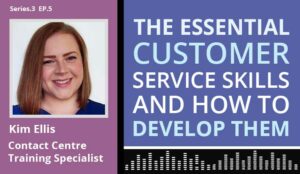We often forget that when a customer contacts the call centre, they don’t want to be making that call. It often comes as a last resort or from a place of agitation.
At the very least, they have to carve out time in their schedule for what they hope is a quick resolution to their problem. After listening through countless automated options and waiting, they finally reach one of your customer service members.
From here, how the customer service agent responds can make or break the customer’s perception of your brand.
With the complexity of technological advancements and the evolving needs of consumers, companies must equip their customer service teams with the necessary skills and knowledge to address concerns properly.
Luckily, it’s easier done than said. In this blog, we delve into the nuances of customer service training, why it’s essential, the psychology behind customer interactions, various training methods, and how we empower organizations to cultivate exceptional customer experiences time and again.
What Is Customer Service Training and Why Is It Important?
Customer service training is more than just imparting knowledge; it’s about nurturing skills that drive customer satisfaction.
It encompasses a myriad of elements, from effective communication and problem-solving to emotional intelligence and conflict resolution.
It’s important to recognize the multifaceted nature of customer service training and incorporate a broad range of solutions tailored to the diverse needs of organizations and their customer service teams.
According to Deloitte, customers spend 140% more with companies with great experience than those who had unsatisfactory ones. But creating a great customer experience isn’t just about providing excellent products and services.
Think about it: How often did you end a monthly service or return a product just because the customer service agent made your experience more frustrating and cumbersome?
Effective training equips customer service reps with the skills to confidently handle diverse customer interactions, increasing customer satisfaction, loyalty, and retention.
The Basics of Customer Psychology for Customer Service
Understanding customer psychology is pivotal in delivering outstanding service. For example, let’s consider Maslow’s Hierarchy of Needs, a psychological theory that categorizes human needs into five levels: physiological, safety, love/belonging, esteem, and self-actualization.
According to Maslow, individuals strive to fulfill lower-level needs before moving on to higher-level ones.
Understanding the hierarchy helps businesses recognize and address customers’ needs effectively in customer support.
By identifying where customers fall within it, support agents can tailor their responses and solutions to meet those needs appropriately, whether providing basic assistance, ensuring safety and security in transactions, fostering a sense of belonging and appreciation, boosting self-esteem, or helping customers achieve their goals.
Understanding and catering to these needs can enhance customer satisfaction, loyalty, and overall experience.
That’s why it’s important to implement training solutions that delve into the fundamentals of customer behavior, enabling teams to anticipate needs, empathize with concerns, and tailor interactions to individual preferences.
By incorporating principles of active listening and empathy, customer service teams can forge deeper connections and foster positive experiences.
5 Types of Training for Customer Service Staff
There are multiple ways to train your team and boost their customer service and professional skills. Here are some of our favorite approaches that are effective, ongoing, and fun:
- Personalized Learning Paths focus on specific areas that align with unique needs and challenges. Whether honing communication skills, building emotional intelligence, or staying updated on the latest technologies, your training platform should tailor the learning experience to individual requirements.
- Microlearning provides in-depth call centre training sessions into bite-sized modules, ideally within their workflow and able to be completed in minutes. The best part is that there are microlearning platforms that can be triggered to automatically go out to agents when learning and performance gaps are detected, and content can instantly be created with the power of generative AI.
- Role-playing Exercises and Customer Interaction Simulations are great ways to help employees practice handling diverse customer needs and expectations. When handling customer requests, there’s no one-size-fits-all approach, and these strategies prepare employees for different interactions while boosting problem-solving and communication skills, as well as empathy and active listening.
- Gamification is the application of game mechanics (leaderboards, levels, badges, points, rewards and recognition, etc.) to a non-game context. By tapping into intrinsic and extrinsic motivators to drive engagement and performance, gamification motivates and engages employees, boosting long-term performance and, ultimately, customer loyalty.
- Real-time Performance Tracking Enables employees to monitor their progress and receive immediate feedback. This real-time visibility enables quick adjustments and interventions, ensuring that they are continuously improving and adapting to the evolving needs of the call centre.
Soft and Hard Skills for Customer Service
The proper training programs should cultivate a blend of soft and hard skills essential for top-notch customer support.
While hard skills encompass product knowledge and technical proficiency, soft skills such as empathy, communication, creative problem-solving, and adaptability are equally crucial in properly addressing customer issues and fostering meaningful customer interactions.
By prioritizing both skill sets, you can ensure that customer service representatives are equipped to deliver outstanding service across diverse scenarios.
Best Practices for Training for Customer Service Staff
Creating an effective customer service training program requires careful planning and alignment with organizational objectives.
Consider using a customizable template for designing tailored training modules, which allows you to address specific skill gaps and business priorities with ease.
And by incorporating interactive elements, real-life scenarios, and continuous feedback mechanisms, you can facilitate an engaging and immersive learning experience for your customer service teams.
Here are some other best practices to consider:
- Implement a blended learning approach combining online courses, workshops, and role-playing exercises to cater to diverse learning styles.
- Foster a culture of continuous learning and development, encouraging team members to actively engage with training materials and seek opportunities for improvement—beyond just the new hire phase.
- Provide regular feedback and performance evaluations to identify areas for growth and celebrate achievements.
- Encourage collaboration and knowledge sharing among team members to leverage collective expertise and best practices.
- Implement gamification elements such as leaderboards, badges, quizzes, and rewards to enhance engagement and motivation.
- Incorporate multimedia content, including videos, podcasts, and infographics, to cater to the diverse learning preferences of frontline workers.
Trends in Customer Service
The world of customer service is growing faster than ever. As costs rise and the competitor landscape widens, customer expectations will continue to climb.
Here are some general trends we’re seeing in customer service you should consider throughout and beyond customer service training programs:
Personalization
Tailoring interactions to individual customer preferences and past behaviors to improve customer relationships.
Omnichannel Support
Seamless integration across multiple communication channels, including social media, chat, and phone.
AI-Powered Solutions
Leveraging artificial intelligence and machine learning to automate routine tasks and enhance service efficiency.
Proactive Engagement
Anticipating customer needs and addressing concerns before they escalate, thereby enhancing overall customer satisfaction.
Summary and Key Takeaways
We’ve just covered some of the basics of customer service training, the psychology of customer interactions, and a few training methods and best practices. A few key takeaways: method.
Great customer service is no longer a nice-to-have; it’s integral to business success and requires continuous training and broadening their knowledge base.
A gamified approach to training empowers organizations to cultivate exceptional customer experiences and learn to de-escalate any situation.
By focusing on soft and hard skills development, organizations can equip their customer service teams to handle diverse customer interactions with confidence.
Incorporating interactive elements, real-life scenarios, and continuous feedback mechanisms enhances engagement and facilitates meaningful learning experiences.
This blog post has been re-published by kind permission of Centrical – View the Original Article
For more information about Centrical - visit the Centrical Website
Call Centre Helper is not responsible for the content of these guest blog posts. The opinions expressed in this article are those of the author, and do not necessarily reflect those of Call Centre Helper.
Author: Centrical
Published On: 8th Apr 2024 - Last modified: 6th Dec 2024
Read more about - Guest Blogs, Centrical






 Centrical provides a real-time performance management, microlearning, gamification, coaching, and voice of the employee platform for frontline teams. The solution inspires and personally guides employee success and growth by making every moment actionable.
Centrical provides a real-time performance management, microlearning, gamification, coaching, and voice of the employee platform for frontline teams. The solution inspires and personally guides employee success and growth by making every moment actionable. 








